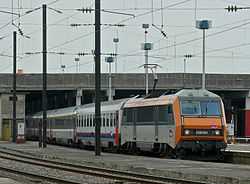Vauban (train)
| Vauban | |
|---|---|
 Vauban departing from Metz, 2008. | |
| Overview | |
| Service type | EuroCity (EC) |
| Status | Operational |
| Locale |
Belgium Luxembourg France Switzerland Italy |
| First service | 29 May 1988 |
| Current operator(s) |
NMBS/SNCB CFL SNCF SBB-CFF-FFS FS |
| Route | |
| Start | Brussels Midi/Zuid |
| End |
Milano C / Brig / Zürich HB / Chur |
| Service frequency | Daily |
| Train number(s) | EC 90/91 |
| Technical | |
| Track gauge | 1,435 mm (4 ft 8 1⁄2 in) |
| Electrification |
15 kV AC, 16.7 Hz (Switzerland) |
The Vauban is an express train that links Brussels Midi/Zuid in Brussels, Belgium, with Switzerland, and previously also extended to Italy. Introduced in 1988, it is operated by the National Railway Company of Belgium (NMBS/SNCB), the Chemins de Fer Luxembourgeois (CFL), the SNCF, the Swiss Federal Railways (SBB-CFF-FFS), and previously also the Italian State Railways (FS).
The train is named after Sébastien Le Prestre (1633–1707), Seigneur de Vauban and later Marquis de Vauban (and commonly referred to as Vauban), who was a Marshal of France and the foremost military engineer of his age.
As of 2013, the Vauban was one of two EuroCity train-pairs running daily between Brussels and Zurich, Switzerland; the other was the EC Iris.[1][2]
History
The Vauban began operating on 29 May 1988, and was classified from the start as a EuroCity (EC) service.[1] It originally carried through coaches to Milano, running via Lugano and Chiasso southbound and via Brig northbound, but was not classified as an EC south of Basel.[1]
In summer 1992, the train's route was changed to run via Brig in both directions, and the train was classified as an EC throughout its route. The section between Brig and Milano later began to operate for only part of the year, and in autumn 2004 it was discontinued entirely, making the EC Vauban 's route Brussels – Basel – Bern – Brig.
In June 2007, the route was diverted to terminate in Interlaken (Ost station);[3] it was soon diverted again, to terminate in Zurich, in December 2007.[4]
Since December 2007, the Vauban has been classified as an InterRegio (IR) on the portion of its route within Switzerland, because it does not meet all the criteria for a EuroCity, but it retains EuroCity status between Brussels and Basel.
See also
- History of rail transport in Belgium
- History of rail transport in France
- History of rail transport in Italy
- History of rail transport in Luxembourg
- History of rail transport in Switzerland
- List of named passenger trains of Europe
References
- ↑ 1.0 1.1 1.2 "Summer services, 1988" (changes taking effect). Thomas Cook European Timetable (April 1988 edition), p. 541. Peterborough, UK: Thomas Cook Publishing.
- ↑ "EuroCity trains: traditional international daytime trains". SNCB Europe website. NMBS/SNCB. Retrieved 23 March 2013.
- ↑ "Summer International Changes". Thomas Cook European Rail Timetable (May 2007 edition), p. 539.
- ↑ "Winter International Services from December 9" (changes scheduled to take effect). Thomas Cook European Rail Timetable (September 2007 edition), p. 540.
External links
- Rail.lu: Vauban – images of the train
| ||||||||||